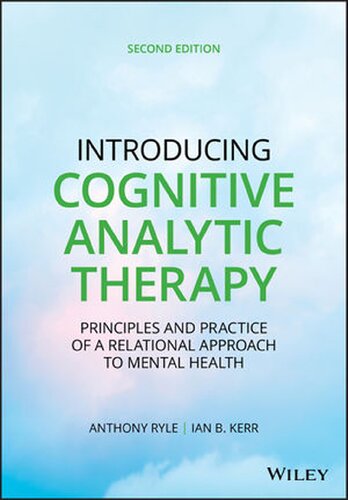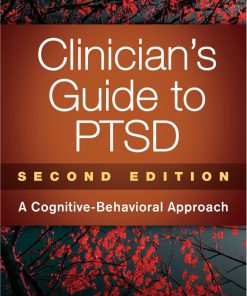Introducing Cognitive Analytic Therapy Principles and Practice of a Relational Approach to Mental Health 2nd Edition by Anthony Ryle, Ian Kerr ISBN 0470972432 9780470972434
$50.00 Original price was: $50.00.$25.00Current price is: $25.00.
Introducing Cognitive Analytic Therapy Principles and Practice of a Relational Approach to Mental Health 2nd Edition by Anthony Ryle, Ian B. Kerr – Ebook PDF Instant Download/Delivery:0470972432 , 978-0470972434
Full download Introducing Cognitive Analytic Therapy Principles and Practice of a Relational Approach to Mental Health 2nd Edition after payment

Product details:
ISBN 10: 0470972432
ISBN 13: 978-0470972434
Author: Anthony Ryle, Ian B. Kerr
Introduces the principles and applications of cognitive analytic therapy (CAT)
Cognitive Analytic Therapy (CAT) is an increasingly popular approach to therapy that is now widely recognised as a genuinely integrative and fundamentally relational model of psychotherapy. This new edition of the definitive text to CAT offers a systematic and comprehensive introduction to its origins, development, and practice. It also provides a fully updated overview of developments in the theory, research, and applications of CAT, including clarification and re-statement of basic concepts, such as reciprocal roles and reciprocal role procedures, as well as extensions into new areas of expertise.
Introducing Cognitive Analytic Therapy: Principles and Practice of a Relational Approach to Mental Health, 2nd Edition starts with a brief account of the scope and focus of CAT and how it evolved and explains the main features of its practice. It next offers a brief account of a relatively straightforward therapy to give readers a sense of the unfolding structure and style of a time-limited CAT. Following that are chapters that consider the normal and abnormal development of the Self and that introduce influential concepts from Vygotskian, Bakhtinian and developmental psychology. Subsequent chapters describe selection and assessment; reformulation; the course of therapy; the ‘ideal model’ of therapist activity and its relation to the supervision of therapists; applications of CAT in various patient groups and settings and in treating personality type disorders; use in ‘reflective practice’; a CAT perspective on the ‘difficult’ patient; and systemic and ‘contextual’ approaches.
- Presents an updated introduction and overview of the principles and practice of cognitive analytic therapy (CAT)
- Updates the first edition with developments from the last decade, in which CAT theory has deepened and the approach has been applied to new patient groups and extended far beyond its roots
- Includes detailed, applicable ‘how to’ descriptions of CAT in practice
- Includes references to CAT published works and suggestions for further reading within each chapter
- Includes a glossary of terms and several appendices containing the CAT Psychotherapy File; a summary of CAT competences extracted from Roth and Pilling; the Personality Structure Questionnaire; and a description of repertory grid basics and their use in CAT
- Co-written by the creator of the CAT model, Anthony Ryle, in collaboration with leading CAT practitioner, trainer, and researcher, Ian B. Kerr
Introducing Cognitive Analytic Therapy is the definitive book for CAT practitioners and CAT trainees at skills, practitioner, and psychotherapy levels. It should also be of considerable interest and relevance to mental health professionals of all orientations, including clinical psychologists, psychiatrists, counselors, mental health nurses, to those working in forensic and various institutional settings, and to a range of other health care and social work professionals.
Introducing Cognitive Analytic Therapy Principles and Practice of a Relational Approach to Mental Health 2nd Table of contents:
1. The Scope and Focus of Cognitive Analytic Therapy (CAT)
-
Summary
-
CAT Is an Integrated Model
-
CAT Is a Collaborative Therapy
-
CAT Is Research-Based
-
CAT Evolved from the Needs of Working in the Public Sector and Remains Ideally Suited to It
-
CAT Is Time-Limited
-
CAT Offers a General Theory, Not Just a New Package of Techniques
-
CAT Has Applications in Many Clinical and Other Settings
2. The Main Features of CAT
-
Summary
-
Background
-
The Early Development of CAT Practice
-
The Theoretical Model
-
The Development of a Vygotskian and Bakhtinian Object Relations Theory
-
The Development of the Basic Model of Practice
-
The Development of Sequential Diagrammatic Reformulation (“Mapping”)
-
The Course of Therapy
-
Time Limits and Ending
-
The Clinical Aims of CAT
-
3. The CAT Model of Development of the Self
-
Summary
-
The CAT Concept of Self
-
Neuroscience Research and the Self
-
The Permeability of the Self
-
Cultural Relativity of Models of Self
-
Studies of Infant Development
-
The Contribution of Vygotsky’s Ideas
-
Developmental Studies of Role Acquisition
-
Bakhtinian Contributions
-
Contrasts with Other Concepts of Self
-
Genetics and Temperament
-
Our Evolutionary Past
-
The Evolution of Cognitive Capacities and of Culture
-
Evolutionarily Pre-programmed Psychological Tendencies
4. The CAT Model of Abnormal Development of the Self and Its Implications for Psychotherapy
-
Summary
-
Abnormal Development of Self and Its Consequences
-
Common Therapeutic Factors
-
Damaged or Abnormal Development of the Self and the CAT Model of Therapeutic Change
-
Understandings of Transference and Counter-Transference and Avoiding Collusion
-
Use of Personal and Elicited Counter-Transference
-
Identifying and Reciprocating Counter-Transference
-
Self-Esteem
-
The “False Self”
-
Who Does the Therapist Speak for?
-
Implications of Our Evolutionary Past for Psychotherapy
-
Concluding Remarks
5. The Practice of CAT: Initial Considerations
-
Summary
-
Referral
-
Assessment Information
-
The Conduct of the Assessment Interview
-
Other Considerations
-
Assessing Motivation
-
Combining CAT with Other Treatment Modes
-
Assessing the Risk of Self-Harm and Suicide
-
Assessing the Potential for Violence
-
“Paper and Pencil” Devices and Questionnaires
-
Treatment “Contracts”
-
-
Concluding Remarks
6. The Practice of CAT: Case Formulation and Reformulation
-
Summary
-
Case Formulation and CAT Reformulation
-
The Process of Reformulation
-
The Reformulation Letter
-
Diagrammatic Reformulation or Mapping
-
The Order and Process of Reformulation
-
Formal Evaluation of the Impact of Reformulation
7. The Practice of CAT: Later Stages and Ongoing Sessions
-
Summary
-
Later Sessions—General Considerations
-
Change and the Working Alliance in the “ZPPD”
-
Making Use of Transference and Counter-Transference in Enabling Change
-
Transference, Counter-Transference, and the Working Relationship of Therapy
-
Dialogic Sequence Analysis
-
Technical Procedures
-
Rating Progress
-
Recognizing Enactments and Procedures as They Occur
-
Recapitulating and Reviewing Sessions
-
Homework
-
Accessing Painful, Possibly Traumatic, Memories and Feelings
-
Not Recognizing Enactments and Procedures as They Occur
-
The CAT Model of Resistance and the “Negative Therapeutic Reaction”
-
Dropping out of Therapy
-
Recognizing Enactments and Procedures at Termination and Ending Well
-
Concluding Remarks
8. The CAT Model of Therapist Activity and Supervision
-
Summary
-
The Competence in CAT (CCAT) Measure
-
Therapist Activities in CAT
-
Supervision of Therapists in CAT
-
Audio-Tape Supervision
-
Dialogical Sequence Analysis
-
“Parallel Process”
-
Group Supervision
-
Reflective Practice
-
Distance Supervision
-
9. CAT in Various Conditions and Contexts
-
Summary
-
The Problem of Diagnosis
-
CAT in Some Specific Conditions and Settings
-
Concluding Remarks
10. The Treatment of “Severe and Complex” Personality-Type Disorders
-
Summary
-
The Concept of Personality Disorder
-
Borderline Personality Disorder (BPD)
-
Aids to Reformulation
-
The Course of Therapy
-
-
Narcissistic Personality Disorder (NPD)
-
The Treatment of “Severe and Complex” Personality-Type Disorders: CAT and the Research Evidence
11. The “Difficult” Patient, Contextual Reformulation, Systemic Applications, and Reflective Practice
-
Summary
-
The “Difficult” Patient
-
Causes of “Difficult” Behavior
-
General Approaches to the “Difficult” Patient
-
-
Contextual Reformulation
-
Constructing a Contextual Reformulation
-
Examples of Contextual Reformulations
-
Broader Uses and Applications of Contextual and Systemic Approaches
-
-
Reflective Practice
Afterword
-
Distinctive Features of CAT
-
The Continuing Expansion of CAT
-
The Evidence Base and Research
-
The Implicit Values of CAT
Glossary
Appendices
-
Appendix 1: The Psychotherapy File
-
Keeping a Diary of Moods and Behavior
-
Patterns that Do Not Work, but Are Hard to Break
-
Different States
-
-
Appendix 2: Cognitive Analytic Therapy (CAT) Competences for Individuals with Personality Disorder
-
Knowledge of CAT Theory
-
Key Features of CAT
-
Reformulation
-
Knowledge of the CAT Theory of BPD
-
Key Skills of CAT
-
Constructing the Sequential Diagrammatic Reformulation (SDR)
-
Constructing Target Problem Procedures (TPPs)
-
Moving Between Task and Process
-
CAT Methods of Intervention
-
Ending Therapy and CAT-Specific Measures
-
Engagement and Positive Change in BPD Treatment
-
-
Appendix 3: Personality Structure Questionnaire (PSQ)
-
Appendix 4: Repertory Grid Basics and the Use of Grid Techniques in CAT
People also search for Introducing Cognitive Analytic Therapy Principles and Practice of a Relational Approach to Mental Health 2nd:
introducing cognitive analytic therapy principles and practice
what is cognitive analytic therapy
cognitive analytic therapy explained
an introduction to brain and behavior 6th edition
mind introduction to cognitive science
Tags:
Anthony Ryle, Ian Kerr,Introducing,Cognitive,Analytic,Therapy,Principles,Practice,Relational,Approach,Mental Health 2nd
You may also like…
Politics & Philosophy - Social Sciences
Psychology - Clinical Psychology
Politics & Philosophy - Social Sciences
Caring A Relational Approach to Ethics and Moral Education 2nd Edition Nel Noddings
Politics & Philosophy
Psychology - Cognitive Psychology
Clinician s Guide to PTSD 2nd ed A Cognitive Behavioral Approach 2nd Edition Steven Taylor
Medicine - Therapy












